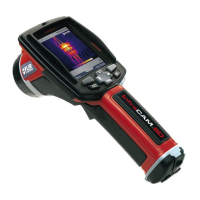12.3.8.4.1 Selection of critical temperature parameter
The BRE information Paper IP17/01 (Information Paper IP17/01, Assessing the Effects
of Thermal Bridging at Junctions and Around Openings. Tim Ward, BRE, 2001) pro-
vides useful guidance on minimum acceptable internal surface temperatures and
appropriate values of Critical Surface Temperature Factor, f
CRsi
. The use of a surface
temperature factor allows surveys under any thermal conditions to show areas that
are at risk of condensation or mould growth under design conditions.
The actual surface temperature will depend greatly on the temperatures inside and
outside at the time of the survey, but a ‘Surface Temperature Factor’ (f
Rsi
) has been
devised that is independent of the absolute conditions. It is a ratio of temperature
drop across the building fabric to the total temperature drop between inside and
outside air.
For internal surveys: f
Rsi
= T
si
– T
e
/ T
i
– T
e
T
si
= internal surface temperature
T
i
= internal air temperature
T
e
= external air temperature
A value for f
CRsi
of 0.75 is considered appropriate across new building as the upper
end usage is not a factor considered in testing for ‘Continuity of Insulation’, or ‘Thermal
Bridging’. However, when considering refurbished or extended buildings, for example
swimming pools, internal surveys may need to account for unusal circumstances.
12.3.8.4.2 Alternative method using only surface temperatures
There are strong arguments for basing thermographic surveys on surface temperatures
alone, with no need to measure air temperature.
■ Stratification inside the building makes reference to air internal temperatures very
difficult. Is it mean air temperature, low level, high level or temperature at the level
of the anomaly and how far from the wall should it be measured?
■ Radiation effects, such as radiation to the night sky, make use of of external air
temperature difficult. It is not unusual for the outside surface of building fabric to
be below air temperature because of radiation to the sky which may be as low as
–50℃ (–58℉). This can be seen with the naked eye by the fact that dew and frost
often appear on building surfaces even when the air temperature does not drop
below the dewpoint.
■ It should be noted that the concept of U values is based on ‘environmental temper-
atures’ on each side of the structure. This is neglected by many inexperienced
analysts.
■ The two temperatures that are firmly related to the transfer of heat through building
fabric (and any solid) are the surface temperatures on each side.
■ Therefore, by referring to surface temperatures the survey is more repeatable.
12
Publ. No. 1558299 Rev. a200 – ENGLISH (EN) – February 12, 2007 109
12 – Introduction to building thermography

